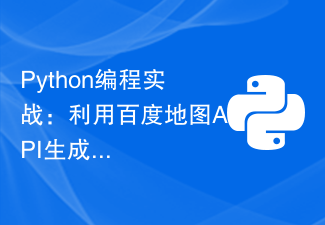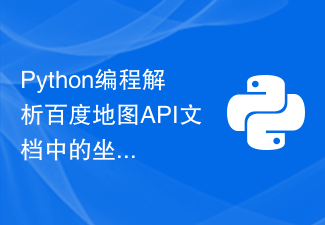Support Vector Clustering (SVC) is an unsupervised learning algorithm based on Support Vector Machine (SVM), which can achieve clustering in unlabeled data sets. Python is a popular programming language with a rich set of machine learning libraries and toolkits. This article will introduce how to use support vector clustering technology in Python.
1. The principle of support vector clustering
SVC is based on a set of support vectors and divides the data set into different clusters by finding the smallest hypersphere. Support vector machine is a supervised learning algorithm that uses a kernel function at the bottom to nonlinearly transform the decision boundary. Support vector clustering applies the properties of support vector machines to clustering without requiring label information. By optimizing the spatial manifold or kernel density, the radius of the hypersphere can be minimized and the training samples can be clicked on the spatial manifold. Perform clustering.
2. Use Python for support vector clustering
In Python, you can use the scikit-learn library to implement SVC. The following are the basic steps to implement support vector clustering:
1. Import the necessary libraries and data sets
import numpy as np import pandas as pd from sklearn.cluster import SpectralClustering from sklearn.datasets import make_blobs from sklearn.preprocessing import StandardScaler import matplotlib.pyplot as plt #使用make_blobs生成随机数据集 X, y = make_blobs(n_samples=300, centers=4, cluster_std=0.60, random_state=0) plt.scatter(X[:, 0], X[:, 1]) plt.show()
2. Data standardization
#标准化数据 scaler = StandardScaler() X = scaler.fit_transform(X) plt.scatter(X[:, 0], X[:, 1]) plt.show()
3. Use support vector clustering Class algorithm for clustering
#使用支持向量聚类 spectral = SpectralClustering(n_clusters=4, gamma=1) spectral.fit(X) y_pred = spectral.labels_.astype(np.int) #可视化聚类结果 plt.scatter(X[:, 0], X[:, 1], c=y_pred) plt.show()
3. Application of support vector clustering
Support vector clustering can be used for clustering in unlabeled data sets. Support vector clustering has been applied in fields such as text clustering, image clustering, and phone record clustering. Support vector clustering is most commonly used for image segmentation because many images are high-dimensional sparse features and different objects and shapes in the image can be discovered by using the SVC algorithm.
In the example introduced in this article, clustering is implemented by generating a random data set and using the SpectralClustering algorithm. It can be seen that the distribution relationship of the four cluster points is obvious.
4. Summary
This article introduces how to use the support vector clustering algorithm in Python, including the implementation process of data set import, data standardization and support vector clustering. Support vector clustering can be used for clustering in unlabeled data sets and has applications in fields such as text clustering, image clustering, and phone record clustering. By practicing support vector clustering technology, you can better understand its principles and application scenarios, and help you further learn and use machine learning algorithms.
The above is the detailed content of How to use support vector clustering technique in Python?. For more information, please follow other related articles on the PHP Chinese website!
 Python中的残差分析技巧Jun 10, 2023 am 08:52 AM
Python中的残差分析技巧Jun 10, 2023 am 08:52 AMPython是一种广泛使用的编程语言,其强大的数据分析和可视化功能使其成为数据科学家和机器学习工程师的首选工具之一。在这些应用中,残差分析是一种常见的技术,用于评估模型的准确性和识别任何模型偏差。在本文中,我们将介绍Python中使用残差分析技巧的几种方法。理解残差在介绍Python中的残差分析技巧之前,让我们先了解什么是残差。在统计学中,残差是实际观测值与
 AssertionError:如何解决Python断言错误?Jun 25, 2023 pm 11:07 PM
AssertionError:如何解决Python断言错误?Jun 25, 2023 pm 11:07 PMPython中的断言(assert)是程序员用于调试代码的一种有用工具。它用于验证程序的内部状态是否满足预期,并在这些条件为假时引发一个断言错误(AssertionError)。在开发过程中,测试和调试阶段都使用断言来检查代码的状态和预期结果是否相符。本文将讨论AssertionError的原因、解决方法以及如何在代码中正确使用断言。断言错误的原因断言错误通
 Python中的分层抽样技巧Jun 10, 2023 pm 10:40 PM
Python中的分层抽样技巧Jun 10, 2023 pm 10:40 PMPython中的分层抽样技巧抽样是统计学中常用的一种数据采集方法,它可以从数据集中选择一部分样本进行分析,以此推断出整个数据集的特征。在大数据时代,数据量巨大,使用全样本进行分析既耗费时间又不够经济实际。因此,选择合适的抽样方法可以提高数据分析效率。本文主要介绍Python中的分层抽样技巧。什么是分层抽样?在抽样中,分层抽样(stratifiedsampl
 Python开发漏洞扫描器的方法Jul 01, 2023 am 08:10 AM
Python开发漏洞扫描器的方法Jul 01, 2023 am 08:10 AM如何通过Python开发漏洞扫描器概述在当今互联网安全威胁增加的环境下,漏洞扫描器成为了保护网络安全的重要工具。Python是一种流行的编程语言,简洁易读且功能强大,适合开发各种实用工具。本文将介绍如何使用Python开发漏洞扫描器,为您的网络提供实时保护。步骤一:确定扫描目标在开发漏洞扫描器之前,您需要确定要扫描的目标。这可以是您自己的网络或任何您有权限测
 如何在Python中使用支持向量聚类技术?Jun 06, 2023 am 08:00 AM
如何在Python中使用支持向量聚类技术?Jun 06, 2023 am 08:00 AM支持向量聚类(SupportVectorClustering,SVC)是一种基于支持向量机(SupportVectorMachine,SVM)的非监督学习算法,能够在无标签数据集中实现聚类。Python是一种流行的编程语言,具有丰富的机器学习库和工具包。本文将介绍如何在Python中使用支持向量聚类技术。一、支持向量聚类的原理SVC基于一组支持向
 Python编程实战:利用百度地图API生成静态地图功能的方法Jul 30, 2023 pm 09:05 PM
Python编程实战:利用百度地图API生成静态地图功能的方法Jul 30, 2023 pm 09:05 PMPython编程实战:利用百度地图API生成静态地图功能的方法导语:在现代社会中,地图已经成为人们生活中不可缺少的一部分。在使用地图时,我们常常需要获取特定区域的静态地图,以便在网页、移动应用或报告中进行展示。本文将介绍如何利用Python编程语言和百度地图API来生成静态地图,并提供相关的代码示例。一、准备工作要实现利用百度地图API生成静态地图的功能,我
 Python编程解析百度地图API文档中的坐标转换功能Aug 01, 2023 am 08:57 AM
Python编程解析百度地图API文档中的坐标转换功能Aug 01, 2023 am 08:57 AMPython编程解析百度地图API文档中的坐标转换功能导读:随着互联网的快速发展,地图定位功能已经成为现代人生活中不可或缺的一部分。而百度地图作为国内最受欢迎的地图服务之一,提供了一系列的API供开发者使用。本文将通过Python编程,解析百度地图API文档中的坐标转换功能,并给出相应的代码示例。一、引言在开发中,我们有时会涉及到坐标的转换问题。百度地图AP
 如何使用C#编写聚类分析算法Sep 19, 2023 pm 02:40 PM
如何使用C#编写聚类分析算法Sep 19, 2023 pm 02:40 PM如何使用C#编写聚类分析算法一、概述聚类分析是一种数据分析方法,通过将相似的数据点分组为簇,将不相似的数据点彼此分开。在机器学习和数据挖掘领域,聚类分析常用于构建分类器、探索数据的结构以及挖掘隐藏的模式。本文将介绍如何使用C#编写聚类分析算法。我们将使用K-means算法作为示例算法,并提供具体的代码示例。二、K-means算法简介K-means算法是最常用


Hot AI Tools

Undresser.AI Undress
AI-powered app for creating realistic nude photos

AI Clothes Remover
Online AI tool for removing clothes from photos.

Undress AI Tool
Undress images for free

Clothoff.io
AI clothes remover

AI Hentai Generator
Generate AI Hentai for free.

Hot Article

Hot Tools

Dreamweaver CS6
Visual web development tools

WebStorm Mac version
Useful JavaScript development tools

Zend Studio 13.0.1
Powerful PHP integrated development environment

SAP NetWeaver Server Adapter for Eclipse
Integrate Eclipse with SAP NetWeaver application server.

Safe Exam Browser
Safe Exam Browser is a secure browser environment for taking online exams securely. This software turns any computer into a secure workstation. It controls access to any utility and prevents students from using unauthorized resources.





